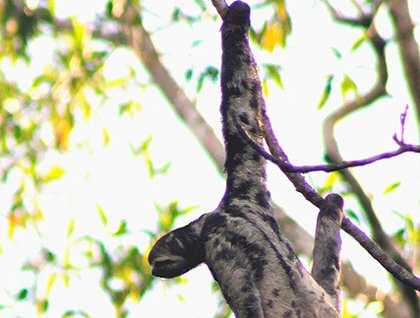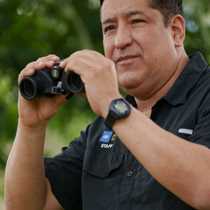A beautiful calm and relatively cool early morning opened our expedition today. We visited one of the many small black water tributaries of the main Ucayali River, Belluda Caño. The water levels of rivers and streams have been decreasing little by little every day in the last couple of weeks. In just a few more weeks it is going to reach its lowest point changing all the area’s ecosystems. Most of the vegetation is already exposed, left high-and-dry, therefore the plants have need of special adaptations to survive after being submerged in water for a long period of time.
This scenario will last for a few months until the water level starts increasing once again. Animal and plant species have evolved with these fascinating yearly cycles for millions of years adapting and using different strategies to survive in the drastically dissimilar conditions they must face. It is a great time of the year to be here in the Upper Amazon rain forest for in a short period of time we can witness such dramatic changes.
We went by skiff for approximately two and the half hours, following first the river’s edge of the Ucayali River and then the course of one the small rivers, Belluda Caño, looking for wildlife. Wildlife is very active in the early hours of the day. We were very lucky for we saw several blue and yellow macaws (Ara ararauna) perching on top of high dead palm trees. Macaws use the hollow palm trees as roosting and nesting homes. Later on we spotted other bird species as well. One of the main attractions was the sighting of a night monkey family (Aotus spp). This nocturnal monkey species is known as a noisy owl monkey as well. This peculiar monkey is the only nocturnal one of the New World primates. Its nocturnal behavior was probably developed to avoid competition during daylight hours with other monkeys and diurnal animals. After breakfast we had a talk about the primates of the area, one of my favorite subjects and an amusing demonstration on how to fold towels using origami techniques.
In the afternoon we explored the Dorado River and its surroundings for about three hours. During this expedition we had a lot of amazing sightings, but the main ones were some three-toed sloths (Bradypus variegatus) hanging on trees and spectacled caimans (Cayman cocodrilus) on the way back to the ship as the night was falling on the rain forest.







